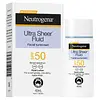What's inside
What's inside
 Key Ingredients
Key Ingredients

 Benefits
Benefits

No benefits
 Concerns
Concerns

 Ingredients Side-by-side
Ingredients Side-by-side

Homosalate 10%
Skin ConditioningOctocrylene 7.5%
UV AbsorberEthylhexyl Salicylate 5%
UV AbsorberBenzophenone-3 5%
UV AbsorberAcrylates/Dimethicone Methacrylate Copolymer 3%
EmollientAscorbic Acid
AntioxidantBHT
AntioxidantBisabolol
MaskingButylene Glycol
HumectantC12-15 Alkyl Benzoate
AntimicrobialCamellia Oleifera Leaf Extract
AstringentCaprylyl Glycol
EmollientCetyl Dimethicone
EmollientChlorphenesin
AntimicrobialCyclopentasiloxane
EmollientDiethylhexyl 2,6-Naphthalate
EmollientDisodium EDTA
Ethylhexylglycerin
Skin ConditioningMannan
Neopentyl Glycol Diheptanoate
EmollientPantothenic Acid
Skin ConditioningParfum
MaskingPentylene Glycol
Skin ConditioningPhenoxyethanol
PreservativePolyester-7
Skin ConditioningPolymethyl Methacrylate
Portulaca Oleracea Extract
Skin ConditioningRetinyl Palmitate
Skin ConditioningSilica
AbrasiveSteareth-100
Gel FormingSteareth-2
EmulsifyingStyrene/Acrylates Copolymer
Tocopheryl Acetate
AntioxidantWater
Skin ConditioningXanthan Gum
EmulsifyingHomosalate 10%, Octocrylene 7.5%, Ethylhexyl Salicylate 5%, Benzophenone-3 5%, Acrylates/Dimethicone Methacrylate Copolymer 3%, Ascorbic Acid, BHT, Bisabolol, Butylene Glycol, C12-15 Alkyl Benzoate, Camellia Oleifera Leaf Extract, Caprylyl Glycol, Cetyl Dimethicone, Chlorphenesin, Cyclopentasiloxane, Diethylhexyl 2,6-Naphthalate, Disodium EDTA, Ethylhexylglycerin, Mannan, Neopentyl Glycol Diheptanoate, Pantothenic Acid, Parfum, Pentylene Glycol, Phenoxyethanol, Polyester-7, Polymethyl Methacrylate, Portulaca Oleracea Extract, Retinyl Palmitate, Silica, Steareth-100, Steareth-2, Styrene/Acrylates Copolymer, Tocopheryl Acetate, Water, Xanthan Gum
 Reviews
Reviews

Ingredients Explained
These ingredients are found in both products.
Ingredients higher up in an ingredient list are typically present in a larger amount.
Homosalate is a chemical sunscreen filter that provides protection in the UV-B range (280nm - 320 nm), with a peak protection at 306 nm. It is internationally approved for use in sunscreens.
Homosalate is not photo-stable, meaning it's strength as a UV filter degrades over time with exposure to the sun. Because of this, it's often used in combination with other chemical sunscreen filters as avobenzone (which protects from the UV-A range). Homosalate also helps act as a solvent for harder-to-dissolve UV filters.
(Part of the reason that sunscreens need to be frequently re-applied is due to the photo instability of many chemical sunscreen filters)
Currently, homosalate is approved in concentrations up to 10% in the EU and 15% in the US. The FDA is currently doing further research on the effects of homosalate, and it is possible that these approved concentrations will change in the future.
Learn more about HomosalateOctocrylene protects skin from sun damage. It absorbs UV-B with peak absorption of 304 nm. It is a common sunscreen ingredient and often paired with avobenzone, a UVA filter. This is because octocrylene stabilizes other sunscreen ingredients by protecting them from degradation when exposed to sunlight. Octocrylene is a photostable ingredient and loses about 10% of SPF in 95 minutes.
Octocrylene also acts as an emollient, meaning it helps skin retain moisture and softens skin. It is oil-soluble and hydrophobic, enhancing water-resistant properties in a product.
Those who are using ketoprofen, a topical anti-inflammatory drug, may experience an allergic reaction when using octocrylene. It is best to speak with a healthcare professional about using sunscreens with octocrylene.
The EU allows a maximum of these concentrations:
Learn more about Octocrylene